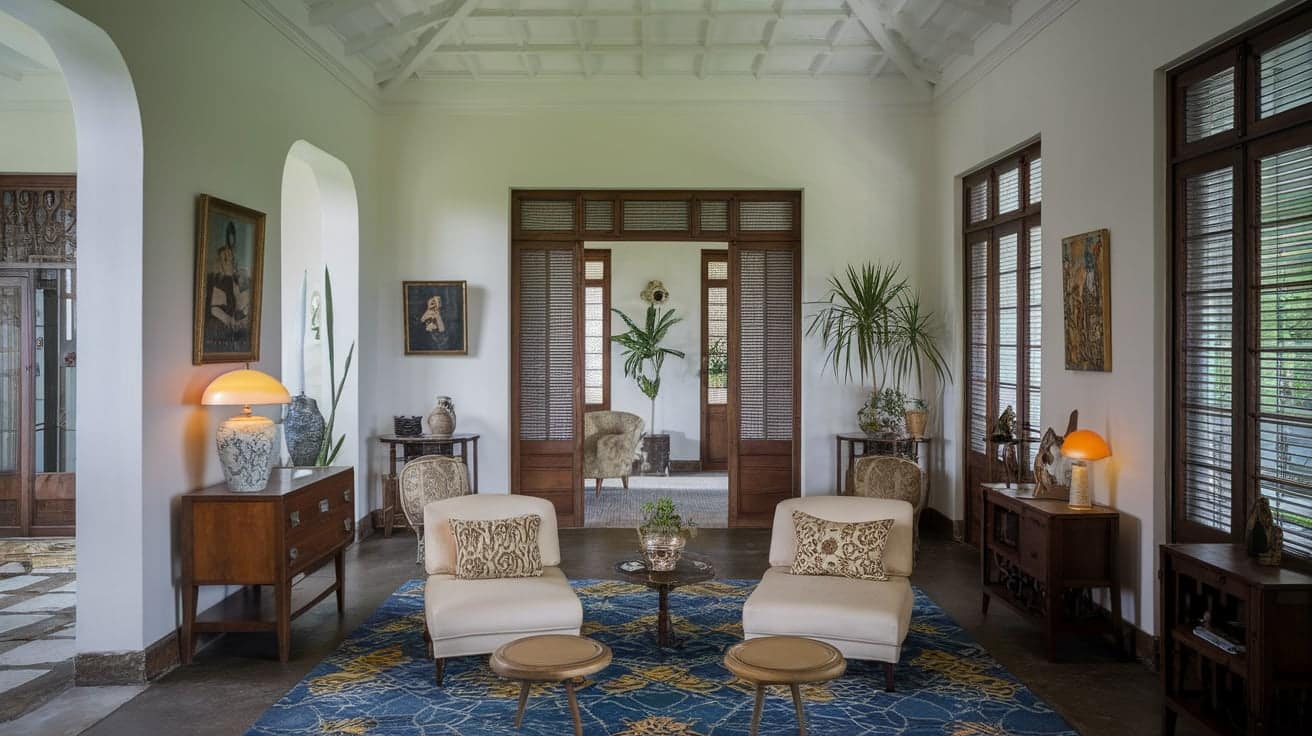Do you long for a home with timeless charm and a touch of global influence? British Colonial style offers exactly that—a perfect balance of formal grace and relaxed comfort that works in almost any setting.
I understand how hard it is to find a design style that feels both sophisticated and livable. That’s why British Colonial interiors are such a great solution. They blend rich woods with light fabrics and exotic touches to create spaces that tell a story.
In this guide, I’ll show you the essential elements of British Colonial design and share practical tips for bringing this look into your home, from color choices to furniture styles and all the finishing touches.
The Historical Roots of British Colonial Interior Design
During the height of the British Empire, colonists traveled to distant lands, including India, Africa, the Caribbean, and Southeast Asia. The hot, humid conditions in these regions forced them to adapt their traditional British decor.
British settlers couldn’t use their typical softwood furniture because it would warp in tropical conditions. Local craftsmen began creating similar pieces using native hardwoods like mahogany, teak, and ebony, often adding their decorative touches.
This blend of formal British design with exotic local influences created a distinctive style that was both practical and beautiful.
The dark woods contrasted with light walls and linens, creating airy spaces that helped combat the heat while maintaining an air of British refinement.
How to Infuse British Colonial Style into Every Room
Bring timeless charm and tropical sophistication into your home—room by room—with these effortless British Colonial styling ideas.
Living Room
The living room should feel both formal and welcoming. For a classic contrast, start with light-colored walls and dark wood floors. Add a substantial sofa in a natural fabric like linen or cotton, paired with rattan or cane chairs for texture.
Accent with botanical prints, warm wood tables, and objects that suggest travel and exploration—perhaps a vintage globe, maps, or artifacts from different cultures. A ceiling fan with wooden blades completes the look while providing practical comfort.
Bedroom
For a true British Colonial bedroom, a four-poster bed in dark wood makes the strongest statement. Layer the bed with crisp white or cream linens, perhaps with subtle tropical motifs in the pillows or throw.
Include plantation shutters or billowing curtains to control light and create a sense of privacy. A rattan chair in the corner, paired with a small side table and reading lamp, offers a cozy spot for relaxation.
Dining Room
A solid wood dining table, preferably in mahogany or teak, anchors the space. Surround it with chairs that blend wood with natural fiber seats or cushions. Above, a ceiling fan or simple chandelier provides both light and air circulation.
A sideboard displays fine china or exotic serving pieces, while a bar cart stocked with glassware recalls the colonial tradition of sunset drinks on the veranda.
Home Office
Create a study that reflects the scholarly side of colonial life with a campaign desk (with folding legs for easy transport), comfortable chair, and shelves filled with books and curiosities.
Add a map on the wall, a magnifying glass on the desk, and perhaps a ship’s model to evoke the spirit of exploration that defined the era.
What Makes British Colonial Style Unique?
British Colonial style follows key principles that make it both practical and beautiful. These basics guide every aspect of the design, from room layout to furniture choices.
Understanding these core concepts will help you create an authentic look in your own home.
1. Adaptation to Climate
British settlers had to adjust their homes for the hot weather. High ceilings allowed warm air to rise away from living spaces. Large windows and doors created cross-breezes to cool rooms naturally. Shutters and verandas provided shade while still allowing airflow.
These cooling features now give the style its open, airy feeling that works well in modern homes. The emphasis on natural ventilation connects to today’s interest in sustainable design.
2. Blend of Cultures
This style mixes classic British furniture forms with local materials and methods. A chair might have the shape of a Georgian piece but be made from tropical wood. Bedding might follow proper British standards but use locally made cotton with native patterns.
This cultural blend gives the style its unique charm and sense of story. Even when newly made, each piece seems to have a history behind it.
3. Functionality & Practicality
Colonial furniture had to work hard in challenging conditions. Campaign pieces folded for travel between posts. Woods were chosen to resist warping in humidity. Raised legs kept items safe from insects and flooding.
These practical touches add character while serving real needs. Today, the same features offer storage solutions and flexibility for changing needs.
4. Connection to Nature
Indoor plants were both decorative and practical, helping to cool and clean the air. Natural materials like rattan, jute, and local woods brought outdoor elements inside. Windows and doors framed views to make the landscape part of the room.
This natural focus feels modern despite its historical roots. It connects to today’s push for bringing nature into our living spaces.
5. Relaxed Polish
While following proper British style rules, colonial homes had a more casual feel. Formal furniture mixed with local pieces created balance. White walls and natural textiles lightened dark woods. The style felt put-together but never stiff.
This relaxed approach to formality makes the style perfect for today’s homes, where we want spaces to feel special but still lived-in and comfortable.
How European Grace Meets Tropical Warmth
A seamless blend of European elegance and tropical practicality, British Colonial style stands out through its rich materials, refined contrasts, and globally inspired charm.
Color Palette
The British Colonial color palette focuses on contrast. Walls are typically painted in light neutrals—whites, creams, and soft beiges—to create a sense of coolness and space. These light backgrounds set off the rich, dark woods of the furniture and floors.
Accent colors draw from nature: soft greens reminiscent of tropical foliage, warm browns, and occasional hints of navy blue or coral that recall the sea and exotic flowers.
Natural Materials
Materials from the tropics form the backbone of this style:
- Dark Woods: Teak, mahogany, and ebony provide substance and warmth
- Rattan and Cane: Used in chairs, headboards, and accent pieces to add texture
- Natural Fibers: Jute and sisal rugs, cotton and linen textiles
These materials not only look beautiful but also serve practical purposes in tropical climates, allowing air to circulate and keeping spaces cool.
Furniture Styles
British Colonial furniture blends European forms with exotic materials:
- Four-poster beds: Often with canopies that originally held mosquito netting
- Campaign furniture: Practical, portable pieces designed for travel
- Plantation chairs: Wide-armed rattan seats built for comfort in hot weather
- Leather trunks: Used both for storage and as decorative side tables
The furniture combines function with beauty, often featuring dark stains and intricate carvings inspired by local motifs.
Colonial Influences: A Global Collaboration
British Colonial style draws from many places around the world. As the British Empire spread, it absorbed design ideas from each region. This mix of cultures is what gives the style its rich, layered look that feels both worldly and personal.
Each area contributed its touch to the style—from the detailed carvings of India to the natural materials of Africa to the breezy feel of Caribbean homes. By picking elements from different regions, you can create your take on the British Colonial style.
| Region | Key Influences | Materials | Colors | Notable Features |
|---|---|---|---|---|
| India | Ornate carvings, detailed woodwork, luxurious textiles | Teak, silk, cotton | Deep reds, gold accents, rich browns | Carved screens, inlaid furniture, paisley patterns |
| Africa | Natural textures, tribal patterns, handcrafted items | Ebony wood, raffia, animal hide | Earth tones, clay reds, sandy beige | Woven baskets, masks as wall art, drum tables |
| Caribbean | Breezy layouts, indoor-outdoor living, casual comfort | Light rattan, bamboo, cotton | Ocean blues, coral, bright white | Plantation shutters, ceiling fans, four-poster beds |
Conclusion
British Colonial interior design offers a timeless appeal that works in many settings, from urban apartments to suburban homes. Its blend of formal structure and relaxed comfort creates spaces that feel both sophisticated and livable.
By focusing on the key elements—contrast between light and dark, natural materials, travel-inspired accessories, and tropical greenery—you can create a British Colonial interior that honors the style’s rich history while meeting your modern needs.
Whether you embrace the full design tradition or incorporate elements that speak to you, British Colonial style provides a connection to a fascinating period of cultural exchange and adaptation.
Have you incorporated British Colonial elements into your home? We’d love to hear about your experiences in the comments below!
Frequently Asked Questions
1. Is the British Colonial Style Expensive to Create?
Not at all—you can find budget-friendly pieces that match the look perfectly at thrift stores, estate sales, and online marketplaces.
2. Can I Mix British Colonial with Other Styles?
Yes, its clean lines and natural materials pair well with modern, coastal, and farmhouse styles.
3. What’s the Easiest Way to Start with This Style?
Begin with a neutral wall color, add one dark wood piece, and include a few plants or botanical prints.
4. Do I Need Antiques for an Authentic Look?
No – many current furniture makers offer pieces with British Colonial style but with modern comfort and durability.














